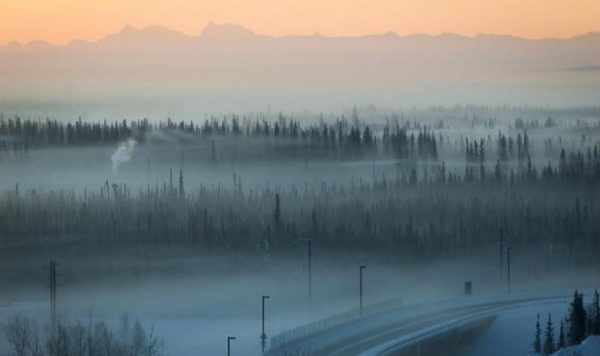
The UAF students say many of their their climate-action plan recommendations would address local problems, like poor wintertime air quality, as well as larger global warming-related issues, such as the need for greater energy efficiency and cleaner-burning fuels that emit less carbon and other harmful pollutants. (KUAC file photo)
The Fairbanks North Star Borough does not have a plan to respond to climate change, like the one under consideration by the Anchorage Assembly, which aims to cut the city’s greenhouse gas emissions by 80 percent within 30 years. But a group of UAF students have come up with recommendations on what a Fairbanks-area climate action plan might look like, and how local leaders could get citizens to buy in to it.
The 17 UAF students came up with their recommendations after studying Anchorage’s climate action plan, along with those from four other Western U.S. and Canadian cities. Their instructor says the students were impressed by the plans’ ambitious goals – like Vancouver, B.C.’s objective to reduce the number of vehicles on the city’s roadways through greater use of public transit, bicycles and pedestrian-friendly urban design.
“They reduced it 50 percent by 2014,” said Associate Professor of Resource Planning Susan Todd. “And they’re continuing to reduce it further.”
Todd says her students also learned the importance of bold proposals, like San Francisco’s 1990 goal to cut back on the amount of solid waste going into the area’s landfills.
“They reduced their waste stream to the landfill by 80 percent by 2010,” Todd said. “That just blew us away!”
Student Kasey Casort is entering her third year as a Natural Resources Management major. And she says the class project helped her understand that in order to get people to back those bold proposals, they must come with a timetable with milestones to ensure progress toward meeting the goal.
“The things that work are things that lofty, but they’re measureable and they’re time-fixed,” Casort said. “So, when they’re writing these goals and these plans, we don’t just think ‘Well, we need to reduce emissions.’ We think we need to reduce emissions by how much, by when.”
Thalia Souza who’s going into her fourth year as a Natural Resources Management major. She says building public support early-on for the plan is essential.
“That’s something we saw lacking in a lot of the plans that we looked at, public engagement,” Souza said. “Planners make these great plans, they think they have all these great ideas, and then they put it out to the public. And they get rejected. Just torn apart.”
Souza says that’s at the top of the list of recommendations the students submitted to borough officials during Wednesday’s Sustainability Commissionmeeting.
“One of our biggest recommendations to Fairbanks was involve people from the beginning, and involve them in your planning process,” Souza said. “Don’t just make a plan and try to shove it down their throats.”
The students say their recommendations are strictly nonpartisan and intended for Fairbanks-area officials who want to put together a local plan in response to a global problem. But environmental advocate and commission member Jimmy Fox says the recommendations also would alleviate the local problem of health-threatening air pollution that sets in on cold winter days.
“The solutions to the (climate) issue are also the same solutions to saving money, creating jobs, having cleaner air,” Fox said.
Fox says a local climate plan would include for example energy-efficiency recommendations like adding insulation to buildings, which would reduce the amount of heating that’s needed and in turn would save money and help clear the air.
“If you weatherize your home,” he said, “in North Pole, the last time this was done, on average a homeowner would save $2,500 a year on their heating bills.”
Borough spokesperson Lanien Livingston said Wednesday that Mayor Bryce Ward is very interested in the UAF students’ recommendations. She says they’ve already contacted him and e-mailed their findings on climate-change strategies from other cities that might work here.
Tim Ellis is a reporter at KUAC in Fairbanks.




